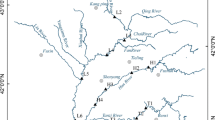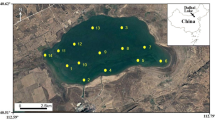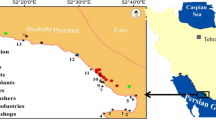Abstract
Sediments are considered as suitable matrices to study the contamination levels of aquatic environment since they represent a sink for multiple contaminant sources. In this study, the influence of sediment characteristics on the distribution of polycyclic aromatic hydrocarbons (PAHs) and its potential risk in euryhaline, freshwater and humic aquatic bodies of Douglas/Stubbs creek, Ikpa River and Eniong River, respectively, were investigated. The level of PAHs in sediment was quantified using GC–MS, while sediment properties including total organic carbon (TOC) content and grain size were determined by the wet oxidation and hydrometer methods, respectively. The results revealed that the total levels of PAHs in sediment varied significantly between the euryhaline, freshwater and humic freshwater ecosystems. In Ikpa River freshwater ecosystem, a total PAHs load of 1055.2 ng/g was recorded with the suites concentration ranging from 13.0 ng/g (for acenaphthylene) to 161 ng/g (for pyrene). The humic ecosystem of Eniong River had a total PAH load of 11.06 ng/g, while the suites level recorded ranged from 0.04 ng/g for acenaphthene to 2.65 ng/g for chrysene. The total level of PAHs detected in the euryhaline Douglas/Stubbs creek was 14.47 ng/g, and suite concentrations varied between 4.27 ng/g for naphthalene and 5.13 ng/g for acenaphthylene. This shows variation in quantity and quality of PAH contaminants with the nature of ecosystems. It implies complex and diverse contamination sources as well as different capabilities to recover from PAH contamination. Correlation analysis has shown that sediment particle and TOC content influenced PAHs burden in bottom sediments, but the effects varied with the molecular weight of PAHs and the nature of the ecosystems. The TOC was the most significant determinant of PAHs load and distribution in sediment of the freshwater Ikpa River and euryhaline Douglas/Stubbs but had little or no influence in the humic sediment of Eniong River, while the influence of particle size was generally indefinite but slightly associated with PAHs accumulation in the euryhaline sediment. Generally, the total PAH levels (11.0–1055.2 ng/g) recorded were low and below the allowable limit for aquatic sediments. The ecological risk assessment revealed that these levels were lower than the effects range low and effects range medium values. This indicates no acute adverse biological effect although the accumulation of PAHs in freshwater ecosystem of Ikpa River may pose ecological risks as most of the carcinogenic PAH suites had relatively high pollution indices compared to other ecosystem types studied.





Similar content being viewed by others
References
Accardi-Dey A, Gschwend PM (2002) Assessing the combined roles of natural organic matter and black carbon as sorbents in sediments. Environ Sci Technol 36(1):21–29
Amellal N, Portal J, Berthelin J (2001) Effect of soil structure on the bioavailability of polycyclic aromatic hydrocarbons within aggregates of a contaminated soil. Appl Geochem 16:1611–1619
Anyakora C, Ogbeche A, Palmer P, Coker H, Ukpo G, Ogah C (2005) GC/MS analysis of polynuclear aromatic hydrocarbons in sediment samples from the Niger Delta region. Chemosphere 60:990–997
Barakat AO, Mostafa A, Wade TL, Sweet ST, El Sayed NB (2011) Distribution and characteristics of PAHs in sediments from the Mediterranean coastal environment of Egypt. Mar Pollut Bull 62:1969–1978
Barhoumi B, LeMenach K, Devier MH, Ameur WB, Etcheber H, Budzinski H, Cachot J, Driss MR (2014) Polycyclic aromatic hydrocarbons (PAHs) in surface sediments from the Bizerte Lagoon, Tunisia: levels, sources, and toxicological significance. Environ Monit Assess 186:2653–2669
Brady N, Weil R (1996) The nature and property of soils, 11th edn. Prentice Hall Inc., Upper Saddle River, p 103
Burkowska A, Donderski W (2007) Impact of humic substances on bacterioplankton in eutrophic lake. Polish Journal of Ecology 55(1):155–160
Cardellicchio N, Buccolieri A, Giandomenico S, Lopez L, Pizzulli F, Spada L (2007) Organic pollutants (PAHs, PCBs) in sediments from the Mar Piccolo in Taranto (Ionian Sea, Southern Italy). Mar Pollut Bull 55:451–458
Dahle S, Savinov VM, Matishov GG, Evenset A, Næs K (2003) Polycyclic aromatic hydrocarbons (PAHs) in bottom sediments of the Kara Sea shelf, Gulf of Ob and Yenisei Bay. Sci Total Environ 306:57–71
Dominquez C, Sarkar S, Bhattacharya A, Chatterjee M, Bhattacharaya BD, Jover E, Albaiges J, Bayona JM, Alam MdA, Satpathy KK (2010) Quantification and source identification of polycyclic aromatic hydrocarbons in core sediments from Sundarbans mangrove wetland, India. Arch Environ Contam Toxicol 59(1):49–61
Ekpo BO, Oyo-Ita OE, Oros DR, Simoneit BRT (2012) Distributions and sources of polycyclic aromatic hydrocarbons in surface sediments from Cross River estuary, SE Niger Delta, Nigeria. Environ Monit Assess 184:1037–1047
El Nemr A, Said TO, Khaled A, El-Sikaily A, Abd-Allah AMA (2007) The distribution and sources of polycyclic aromatic hydrocarbons in surface sediments along the Egyptian Mediterranean coast. Environ Monit Assess 124:343–359
Essien JP, Eduok SI, Olajire AA (2011) Distribution and ecotoxicological significance of polycyclic aromatic hydrocarbons in sediments from Iko River estuary mangrove ecosystem. Environ Monit Assess 176:99–107
Essien JP, Ebong GA, Asuquo JE, Olajire AA (2012) Hydrocarbons contamination and microbial degradation in mangrove sediments of the Niger Delta region (Nigeria). Chem Ecol 28(5):421–434
Froehner S, Maceno M, Luz ECD, Souza DB, Mechado KS (2010) Distribution of polycyclic aromatic hydrocarbons in marine sediments and their potential toxic effects. Environ Monit Assess 168:205–213
Gobas FAPC, Maclean LG (2003) Sediment-water distribution of organic contaminants in aquatic ecosystems: the role of organic carbon mineralization. Environ Sci Technol 37:735–741
He X, Pang Y, Song X, Chen B, Feng Z, Ma Y (2014) Distribution, sources and ecological Risk assessment of PAHs in surface sediments from Guan River Estuary, China. Mar Pollut Bull 80:52–58
Inam E, Offiong N, Essien J, Kang S, Kang S, Antia B (2016) Polycyclic aromatic hydrocarbons loads and potential risks in freshwater ecosystem of the Ikpa River Basin, Niger Delta—Nigeria. Environ Monit Assess 188(1):49. https://doi.org/10.1007/s10661-015-5038-9
Johnson M, Huang W, Weber W (2001) A disturbed reactivity model for sorption by soils and sediments. 13. Simulated diagenesis of natural sediment organic matter and its impact on sorption/desorption equilibria. Environ Sci Technol 35:1680–1687
Jones B (2001) Laboratory guide for conducting soil tests and plant analysis. CRC Press, Boca Raton, pp 139–148
Kannam K, Johnsom-Restrepo B, Yohn SS, Giesy JP, Long DT (2005) Spatial and temporal distribution of polycyclic aromatic hydrocarbons in sediments from Michigan inland lakes. Environ Sci Technol 39:4700–4706
Kelley J, Arias-Rodriguez L, Martin D, Yee M, Bustamante C, Tobler M (2016) Mechanisms underlying adaptation to life in hydrogen sulfide-rich environments. Mol Biol Evol 33(6):1419–1434. https://doi.org/10.1093/molbev/msw020
Kim HC, Yu MJ, Han I (2006) Multi-method study of the characteristic chemical nature of aquatic humic substances isolated from the Han River, Korea. Appl Geochem 21(7):1226–1239
King AJ, Readman JW, Zhou JL (2004) Dynamic behaviour of polycyclic aromatic hydrocarbons in Brighton Marina, UK. Mar Pollut Bull 48:229–239
Knaebel DB, Vestal JR, Federle TW, McAvoy DC (1996) Microbial mineralization of organic compounds in an acidic agricultural soil: effects of preadsorption to various soil constituents. Environ Toxicol Chem 15(11):1865–1875
Lang Y, Wang N, Gao H, Bai J (2012) Distribution and risk assessment of polycyclic aromatic hydrocarbons (PAHs) from Liaohe estuarine wetland soils. Environ Monit Assess 184:5545–5552
Li CH, Wong YS, Tam NFY (2010) Anaerobic biodegradation of polycyclic aromatic hydrocarbons with amendment of iron(III) in mangrove sediment slurry. Biores Technol 101(21):8083–8092
Liu Y, Beckingham B, Ruegner H, Li Z, Ma L, Schwientek M, Xie H, Zhao J, Grathwohl P (2013) Comparison of sedimentary PAHs in the rivers of Ammer (Germany) and Liangtan (China): differences between early- and newly- industrialized countries. Environ Sci Technol 47:701–709
Lohmann R, MacFarlane JK, Gschwend PM (2005) Importance of black carbon to sorption of native PAHs, PCBs, and PCDDs in Boston and New York Harbor sediments. Environ Sci Technol 39(1):141–148
Long ER, MacDonald DD, Smith SL, Calder FD (1995) Incidence of adverse biological effects within ranges of chemical concentrations in marine and estuary sediments. Environ Manage 19:81–97
Ma C, Ye S, Lin T, Ding X, Yuan H, Guo Z (2014) Source apportionment of polycyclic aromatic hydrocarbons in soils of wetlands in the Liao River Delta, Northeast China. Mar Pollut Bull 80:160–167
Mac Rae J, Hall K (1998) Biodegradation of polycyclic aromatic hydrocarbons (PAHs) in marine sediment under denitrifying conditions. Water Sci Technol 38:177–185
Manoli E, Samara C (1999) Polycyclic aromatic hydrocarbons in natural waters: sources, occurrence and analysis. Trends Anal Chem 18(6):417–427
Maskaoui K, Zhou JL, Hong HS, Zhang ZL (2002) Contamination by polycyclic aromatic hydrocarbons in the Jiulong River Estuary and Western Xiamen Sea, China. Environ Pollut 118:109–122
Mitra S, Dellapenna T, Dickhut R (1999a) Polycyclic aromatic hydrocarbon distribution within lower hudson river estuarine sediments: physical mixing vs sediment geochemistry. Estuar Coast Shelf Sci 49(3):311–326
Mitra S, Dickhut RM, Kuehl SA, Kimbrough KL (1999b) Polycyclic aromatic hydrocarbon (PAH) source, sediment deposition patterns, and particle geochemistry as factors influencing PAH distribution coefficients in sediments of the Elizabeth River, VA, USA. Mar Chem 66:113–127
Nam J, Thomas G, Jaward F, Steinnes E, Gustafsson O, Jones K (2008) PAHs in background soils from Western Europe: influence of atmospheric deposition and soil organic matter. Chemosphere 70:1596–1602
Ouyang Y, Zhang J, Ou L (2006) Temporal and spatial distributions of sediment total organic carbon in an estuary river. J Environ Qual 35(1):93–100
Perera FP, Hemminki K, Gryzbowska E, Motykiewicz G, Michalska J, Santella RM, Young T, Dickey C, Brandt-Rauf P, DeVivo I, Blaner W, Tsai W, Chorazy M (1992) Molecular and genetic damage in humans from environmental pollution in Poland. Nature 360:256–258
Pouneva ID (2005) Effect of humic substances on the growth of microalgal cultures. Russ J Plant Physiol 52:410. https://doi.org/10.1007/s11183-005-0060-3
Rahmanpoor S, Ghafourian H, Hashtroudi SM, Bastani KD (2014) Distribution and sources of polycyclic aromatic hydrocarbons in surface sediments of the Hormuz Strait, Persian Gulf. Mar Pollut Bull 78:224–229
Ratola N, Lacorte S, Alves A, Barcelo D (2006) Analysis of polycyclic aromatic hydrocarbons in pine needles by gas chromatography-mass spectrometry: comparison of different extraction and clean-up procedures. J Chromatogr A 1114:198–204
Rockne KJ, Shor LM, Young LY, Taghon GL, Kosson DS (2002) Distributed sequestration and release of PAHs in weathered sediment: the role of sediment structure and organic carbon properties. Environ Sci Technol 36:2636–2644
Sandoli RL, Ghiorse WC, Madsen EL (1996) Regulation of microbial phenanthrene mineralization in sediment samples by sorbent-sorbate contact time, inocula and gamma irradiation-induced sterilization artifacts. Environ Toxicol Chem 15(11):1901–1907
Schindler DW, Kidd KA, Muir DCG, Lockhart WL (1995) The effects of ecosystem characteristics on contaminant distribution in northern freshwater lakes. Sci Total Environ 160:1–17
Skupinska K, Misiewicz I, Kasprzycka-Guttman T (2004) Polycyclic aromatic hydrocarbons: physicochemical properties, environmental appearance and impact in living organisms. Acta Pol Pharmacuetica Drugs Res 61:233–240
Sojinu OS, Wang J, Sonibare OO, Zeng EY (2010) Polycyclic aromatic hydrocarbons in sediments and soils from oil exploration areas of the Niger Delta, Nigeria. J Hazard Mater 174:641–647
Sprovieri M, Feo ML, Prevedello L, Manta DS, Sammartino S, Tamburrino S, Marsella E (2007) Heavy metals, polycyclic aromatic hydrocarbons and polychlorinated biphenyls in surface sediments of the Naples harbour (southern Italy). Chemosphere 67:998–1009
Tao S, Cao H, Liu W, Li B, Cao J, Xu F, Wang X, Coveney R, Shen W, Qin B, Sun R (2004) Fate modeling of phenanthrene with regional variation in Tianjin, China. Environ Sci Technol 37:2453–2459
Udo EJ, Ibia TO, Ogunwale JA, Ano AO, Esu IE (2009) Manual of soil, plant and water analyses. Sibon Books Ltd, Lagos, pp 11–13
Udofia E, Inam E, Abraham N, Asamudo N, Essien J (2015) Crude oil and PAH degrading bacteria isolated from humic freshwater ecosystem of Eniong River—Nigeria. Paper presented at the 1st UNIUYO & GIST Joint Programme Workshop held in Abuja, Nigeria. 15–18 June
Udosen ED, Udoh AP, Ekong CI (2004) Variations in trace metal levels in sediments from Ikpa River in Itu Area of Akwa Ibom State, Nigeria. J Appl Sci 7:4229–4240
Udosen E, Benson N, Essien J (2007) Trends in heavy metals and total hydrocarbon burdens in Stubbs Creek A tributary of Qua Iboe River Estuary, Nigeria. Trends Appl Sci Res 2(4):312–319
United States Environmental Protection Agency (US EPA) (2007) US EPA Method 8270D –Semivolatile organic compounds by gas chromatography/mass spectrometry (GC/MS). U.S.EPA, Washington, pp 15–67
Wang R, Liu G, Chou C, Liu J, Zhang J (2010) Environmental assessment of PAHs in soils around the Anhui Coal District, China. Arch Environ Contam Toxicol 59(1):62–70
Warren N, Allan IJ, Carter JE, House WA, Parker A (2003) Pesticides and other micro-organic contaminants in freshwater sedimentary environments—a review. Appl Geochem 18:159–194
Wentworth CK (1992) A scale of grade and class terms for clastic sediments. J Geol 30:377–392
Witt G (1995) Polycyclic aromatic hydrocarbons in water and sediment of the Baltic Sea. Mar Pollut Bull 31:237–248
Wu F, Xu L, Sun Y, Liao H, Zhao X, Guo J (2012) Exploring the relationship between polycyclic aromatic hydrocarbons and sedimentary organic carbon in three Chinese lakes. J Soils Sediments 12:774–783
Yang Y, Zhang N, Xue M, Lu ST, Tao S (2011) Effects of soil organic matter on the development of the microbial polycyclic aromatic hydrocarbons (PAHs) degradation potentials. Environ Pollut 159(2):591–595
You C, Jia C, Pan G (2010) Effect of salinity and sediment characteristics on the sorption and desorption of perfluorooctane sulfonate at sediment-water interface. Environ Pollut 158:1343–1347
Yu H, Xiao H, Wang D (2014) Effects of soil properties and biosurfactant on the behavior of PAHs in soil-water systems. Environ Syst Res 3(6):1–11
Yun T, Tianling Z, Xinhong W (2003) PAH contamination and PAH-degrading bacteria in Xiamen Western Sea. Chem Speciat Bioavailab 14:25–34
Zuloaga O, Prieto A, Usobiaga A, Sarkar SK, Chatterjee M, Bhattacharya BD, Bhattacharya A, Alam MA, Satpathy KK (2009) Polycyclic aromatic hydrocarbons in intertidal marine bivalves of Sunderban mangrove wetland, India: an approach to bioindicator species. Water Air Soil Pollut 201:305–318
Zuloaga O, Prieto A, Ahmed K, Sarkar SK, Bhattacharya AK, Chatterjee M, Bhattacharaya BD, Satpathy KK (2013) Distribution of polycyclic aromatic hydrocarbons in recent sediments of Sundarban mangrove wetland of India and Bangladesh: a comparative approach. Environ Earth Sci 68:355–367
Acknowledgements
This study was supported by the Ministry of Science and Technology in South Korea through the Institute of Science and Technology for sustainability (UNU & GIST joint programme) in 2014 and 2016. We thank the two anonymous reviewers whose comments improved the quality of the original manuscript.
Author information
Authors and Affiliations
Corresponding author
Rights and permissions
About this article
Cite this article
Inam, E., Etuk, I., Offiong, NA. et al. Distribution and ecological risks of polycyclic aromatic hydrocarbons (PAHs) in sediments of different tropical water ecosystems in Niger Delta, Nigeria. Environ Earth Sci 77, 216 (2018). https://doi.org/10.1007/s12665-018-7396-4
Received:
Accepted:
Published:
DOI: https://doi.org/10.1007/s12665-018-7396-4




